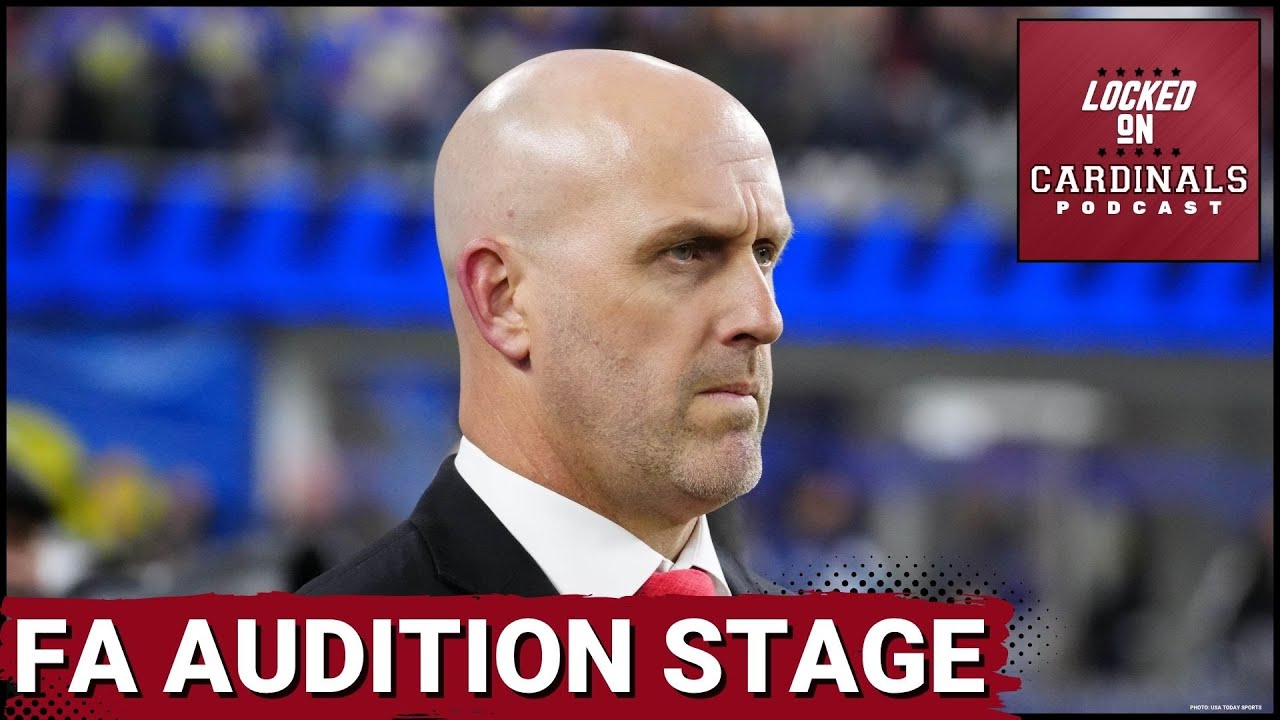The Arizona Cardinals have positioned themselves perfectly—no longer desperate in free agency, but in control. That’s a far cry from the state of the franchise just a couple of years ago, when the team was mired in uncertainty, battling a roster riddled with holes, an injured franchise quarterback, and a front office desperately trying to stay afloat amid an inevitable rebuild. Now, under the leadership of general manager Monti Ossenfort and head coach Jonathan Gannon, the Cardinals are no longer scrambling to fill glaring needs with stopgap free agents. Instead, they’ve built a solid foundation that allows them to approach free agency with a sense of calm, precision, and leverage.
This transformation didn’t happen overnight. It’s been the product of a patient, methodical strategy—one that prioritized the draft, cap flexibility, internal development, and a cultural shift in the locker room. Ossenfort’s vision has always been clear: establish long-term sustainability over short-term band-aids. The 2024 offseason marked a turning point in that process. The Cardinals, armed with an abundance of draft capital, used their selections wisely to address major needs at wide receiver, offensive line, and defense, while retaining cap space and avoiding overpriced veterans.
The return of a healthy Kyler Murray was perhaps the biggest “addition” of all. When Murray is on the field, the entire identity of the team changes. His dual-threat ability gives Arizona a dynamic edge that few teams possess. Having him healthy again means the Cardinals don’t need to overpay for quarterback insurance or force plays around a limited backup. Murray’s presence alone steadies the ship, allowing the front office to focus on building around him rather than scrambling to cover for his absence.
Another key factor in the Cardinals’ newfound position of strength is their young core. In recent drafts, Arizona has quietly assembled one of the more promising collections of young talent in the league. Players like Paris Johnson Jr., Trey McBride, Zaven Collins, and BJ Ojulari have all shown flashes of star potential, and now those players are entering critical development years where they could break out. The 2024 rookie class, headlined by wide receiver Marvin Harrison Jr., only adds to that momentum. Instead of shopping in free agency for expensive skill position players, the Cardinals can now focus on integrating Harrison and letting their young core grow together under Gannon’s guidance.
The roster’s balance and flexibility are also noteworthy. Arizona isn’t entering free agency with a dozen red-alert positions like in the past. There’s a structure in place, and while no roster is ever perfect, the Cardinals aren’t forced to overextend just to remain competitive. That’s a powerful advantage. It means Arizona can hunt for value, wait for prices to drop, and focus on complementary pieces rather than franchise saviors. It’s the difference between signing a player like Calais Campbell to mentor young defenders, rather than begging a top-tier pass rusher to come in and carry the entire unit.
This new approach also reflects in the tone around the franchise. There’s a sense of direction, identity, and accountability that wasn’t always present in previous regimes. Jonathan Gannon has instilled a culture rooted in effort, toughness, and preparation. Players know what’s expected of them. There’s a system in place, and the locker room is buying in. That cultural shift makes Arizona a more attractive destination for free agents—not because of glitz or hype, but because of structure and opportunity.
Financially, the Cardinals are in a strong position as well. They’ve managed their salary cap wisely, avoiding the bloated deals that sink teams into multi-year holes. This gives Ossenfort and his staff flexibility to pounce when the right player becomes available, whether that’s before the season, at the trade deadline, or in future offseasons. It’s all part of the long game Arizona is now playing, and that’s a massive upgrade from the reactive, patchwork strategies of the past.
This isn’t to say the Cardinals won’t participate in free agency at all. They absolutely will. But they’ll do so on their own terms, not out of desperation. That distinction matters. It’s the difference between building with purpose and spending out of panic. Ossenfort and his team are now in a position to target role players and veteran leaders who fit specific needs and cultural traits. They’re not trying to “win” free agency with splashy signings—they’re trying to win on Sundays by building the most cohesive, balanced roster possible.
Fans should be encouraged by this direction. It’s easy to get caught up in the headlines and think that the biggest spenders are the biggest winners in March. But the NFL has taught us repeatedly that free agency is often a trap for impatient teams. The real winners are usually the ones who draft well, develop internally, and use free agency to strategically plug gaps—not overhaul their rosters every year. Arizona is starting to follow that blueprint, and it’s already yielding results.
The team’s draft performance in 2024 was a microcosm of this approach. Rather than panicking and reaching for needs, the Cardinals let the board come to them. They landed arguably the best wide receiver prospect in a generation in Marvin Harrison Jr., filled out the offensive and defensive lines with high-upside talent, and added depth to the secondary. These are foundational moves—not flashy, but essential for long-term success. And with players like Budda Baker still anchoring the defense, there’s a mix of veteran leadership and youth that creates a stable locker room dynamic.
Another underrated benefit of the Cardinals’ new status is the flexibility it gives them in negotiations. When teams know you’re desperate, agents smell blood. They know they can leverage your weaknesses to inflate prices and extract guarantees. But when you’re perceived as a stable, patient franchise with internal solutions already in place, you hold the power. That shift in perception can save millions and allow teams to sign higher character, better-fitting players instead of whoever happens to be the top available name at a position of need.
Injuries, of course, will still be part of the game. And depth will always be tested in the NFL. But Arizona is finally in a position where one injury doesn’t unravel the entire operation. That’s the true test of roster building—resilience. The Cardinals’ front office deserves credit for constructing a team that’s becoming deeper, tougher, and more adaptable with each passing season.
Looking ahead, the Cardinals are in an ideal position to continue building on this momentum. They have future cap space, additional draft capital, and a franchise quarterback they believe in. They’re no longer tied down by bad contracts or forced to make deals under pressure. They’ve reached a level of organizational maturity that should give fans real hope—not just for competitiveness, but for consistent success.
There’s still work to be done. Every NFL team is a few key injuries or bad decisions away from falling off track. But for the first time in a long time, the Arizona Cardinals are operating from a position of strength. They’re not needy, they’re not reckless, and they’re not chasing headlines. They’re building something sustainable, and that’s the kind of franchise identity that leads to playoff contention—and eventually, championship runs.
In the wild world of the NFL offseason, where chaos often rules and desperate teams overpay for average talent, the Arizona Cardinals are quietly crafting a smarter path forward. No longer participants in the annual scramble for quick fixes, they’ve chosen patience, vision, and calculated decision-making. And now, they’re in the rare position of not needing free agency to fix everything—just to finish what they’ve already started.



